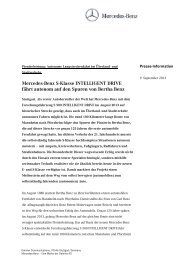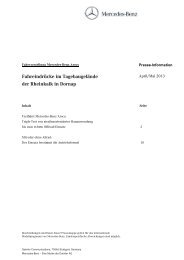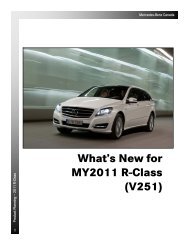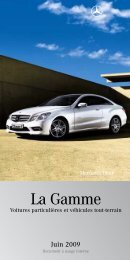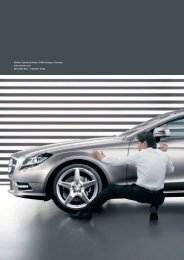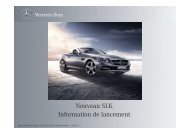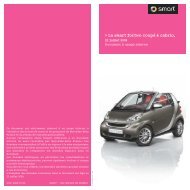Mercedes-Benz Bus History - Daimler
Mercedes-Benz Bus History - Daimler
Mercedes-Benz Bus History - Daimler
You also want an ePaper? Increase the reach of your titles
YUMPU automatically turns print PDFs into web optimized ePapers that Google loves.
But that was not possible without a special chassis. Its frame cranked<br />
downwards behind the front axle and then continued on straight to the<br />
rear. At the rear it made an upward bend again to create the<br />
necessary space for the rear axle. The reward for this effort was that<br />
the floor was now just 670 millimeters above the roadway.<br />
A board divided the entrance into two steps of a little more than 300<br />
millimeters: that would be entirely acceptable for a regular service bus<br />
even today.<br />
But the low frame afforded a number of other advantages. For<br />
example, the lower center of gravity which this means improved<br />
vehicle behavior. Which in turn distinctly enhanced both comfort and<br />
safety mainly on interurban coaches with heavily laden roof luggage<br />
racks. A brochure of the period put this advantage in a nutshell: “As a<br />
result of the low position of the body, the vehicle runs more smoothly<br />
and rocks less than a bus of conventional high design.” On top of that,<br />
buses with the low frame and a correspondingly lower slung body do<br />
not appear so stilted and look far more elegant than their<br />
counterparts. This optical break with the truck was a most welcome<br />
distinguishing feature for the new industry of passenger<br />
transportation.<br />
The bus emancipates itself from the truck<br />
Emancipation included a characteristic long wheelbase, which in turn<br />
made it possible for almost all passenger seats to lie between the<br />
axles, where seating is most comfortable. This had the further effect<br />
that the body generally had to endure less strain. And this provided<br />
the opportunity to go over to a generally more lightweight design<br />
“which has a favorable influence on tire wear and fuel consumption,”<br />
as a 1925 brochure told the customers.<br />
<strong>Daimler</strong> Communications, 70546 Stuttgart/Germany<br />
Page 8






